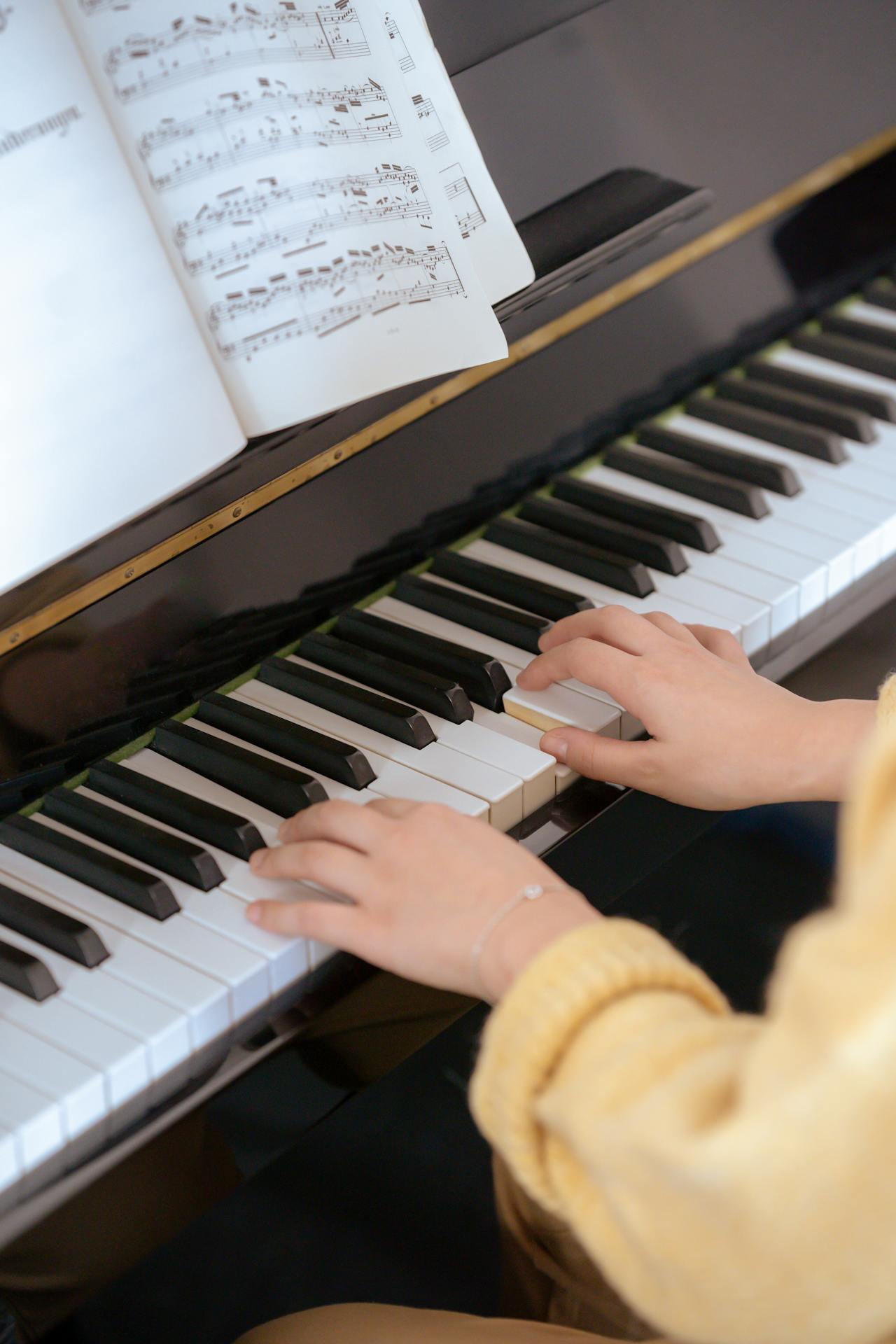Expert Music Therapy, Austin, TX
Music Therapy: Healing, Connection, and Expression for All Ages and Abilities
At Integrative Creative Therapy, Music therapy in Austin, TX, offers compassionate, evidence-based care through board-certified music therapists.


Compassionate Music Therapy Austin for All Ages
Music Meets Us Exactly Where We Are
Music has a remarkable way of meeting us exactly where we are. It engages the brain, body, and emotions simultaneously, offering a pathway to connection, self-expression, and growth.
At every stage of life and across diverse abilities, music therapy provides a safe, creative, and supportive space to explore, express, and connect.
At Integrative Creative Therapy, our board-certified music therapists provide trauma-informed care throughout Downtown, University Hill, Westcott, Eastwood, and surrounding Austin neighborhoods.
We offer individual and group music therapy sessions designed to support emotional expression, nervous system regulation, and authentic connection.




When Words Aren't Enough, Music Speaks
Some experiences live so deeply in the body that words alone can’t reach them. Music opens another doorway, a way to express, feel, and connect when language isn’t enough. Whether healing from trauma, navigating life as a neurodivergent person, or seeking comfort and connection through aging, music can meet people exactly where they are.
Our music therapy Austin services support people throughout University Hill, Westcott, and Eastwood who are seeking alternative pathways to healing and connection.
Board Certified Music Therapy, Austin, Texas
Why Music Works
Music activates more areas of the brain simultaneously than any other human activity. It bypasses pathology, limitation, and impairment, reaching the healthy core and the deeper layers of emotional experience.
Some Of The Key Benefits Are:
Evidence-Based Music Therapy, Austin, TX
- Expressing emotions and easing pain and anxiety
- Sharpening focus and building self-trust and confidence
- Supporting nervous system regulation and emotional resilience for adults processing trauma
- Awakening meaningful memories and calming anxiety for older adults
- Creating opportunities for connection, joy, and shared experiences
Through sound, rhythm, and creative exploration, music helps restore what trauma, stress, or aging may have taken away … a sense of aliveness, belonging, and self-trust. Music therapy throughout Austin, Texas, provides accessible care for diverse needs and populations.
Transform Disconnection Into Creative Expression
- Feeling trapped in anxiety and racing thoughts
- Carrying numbness and emotional disconnection
- Avoiding social connections due to fear or exhaustion
- Struggling to express what lives beyond words
- Living in hypervigilance after trauma
Go From:
- Experiencing groundedness through rhythm and breath
- Reconnecting with feelings through sound and melody
- Building meaningful relationships in supportive group settings
- Finding voice and expression through creative music-making
- Reclaiming safety in the body and nervous system
To This:

Who Music Therapy Can Support
Music therapy can be especially helpful if you’re:
- Finding talk therapy is limited
- Neurodivergent
- Navigating anxiety, depression, or burnout
- Healing from trauma or loss
- Feeling disconnected from your body or emotions
- Searching for a creative outlet to process feelings
- Caring for others and longing to feel cared for yourself
- Experiencing memory loss
- Recovering from a stroke or brain injury
We also offer creative arts and music therapy groups designed for adults, teens, and children to enhance creative expression, emotional regulation, and quality of life. Explore our group therapy services to learn more about shared healing experiences.
Music Therapy Austin, Texas, for Diverse Needs



Explore How Music Therapy Can Support You
Anxiety, depression, trauma, neurodivergence, and memory loss can disconnect people from themselves and their capacity for joy. Music therapy addresses mental health, developmental, cognitive, and emotional challenges through evidence-based interventions. Our music therapists in Austin, TX, provide individualized care for all ages navigating various life experiences and conditions.
We offer specialized music therapy support for:
- Trauma Healing
- Neurodiversity
- Aging and Memory
Licensed Music Therapist, Austin, for Mental Health
Music Therapy for Trauma Healing
Licensed Music Therapist, Austin, for Mental Health
Explore How Music Therapy Can Support You
Trauma can leave people feeling trapped in their bodies or disconnected from them entirely. Moments of numbness, exhaustion, or hypervigilance arrive without fully understanding why. Music therapy offers a gentle, embodied way to reconnect to self, one sound, one breath, one heartbeat at a time.
Somewhere inside, the body still remembers safety. Music and breath are two of the most direct ways to return to that place. When rhythm meets breath, the nervous system begins to settle, the body softens, and space opens for healing to unfold naturally.
Our trauma-informed music therapy approach includes:
- Regulating nervous systems through rhythm and vocal engagement
- Processing emotions that feel too overwhelming for words
- Rebuilding trust in body sensations and internal experiences
- Developing grounding techniques using sound and breath
- Creating safe containers for deep emotions to emerge and transform
Music therapy for trauma in Austin provides compassionate support across Downtown, Eastwood, and University Hill. Learn more about our EMDR therapy in Austin for integrated trauma healing approaches.
Music Therapy for Neurodiversity
Music Therapy for Autism and ADHD, Austin
Every Person Has Their Own Rhythm
Music therapy offers a safe and engaging space for neurodivergent individuals, including those on the autism spectrum, with ADHD, sensory processing differences, or other experiences, to explore, express, and connect.
Music has a unique power to reach people on many levels at once. It engages language, movement, emotion, cognition, and memory simultaneously, more than any other human activity. In doing so, it bypasses limitations and connects with the healthy, expressive core within each person, offering a pathway to self-expression, connection, and healing.
Music therapy helps neurodivergent individuals develop:
- Language and communication skills through singing and vocalization
- Social connection and collaboration through shared music-making
- Emotional expression through nonverbal outlets
- Motor skills and coordination through rhythm and movement
- Self-esteem and confidence through affirming creative processes
Our music therapy Austin services provide neurodivergent-affirming care throughout University Hill and Northside. Explore music therapy for ADHD in Austin for specialized support.
Music Therapy for Dementia, Austin, Texas
Music Therapy for Autism and ADHD, Austin
Music Carries Memory, Emotion, and Identity
Aging can bring beautiful experiences, but it can also come with challenges: memory changes, cognitive decline, or difficulties with emotional expression. Music therapy offers a gentle, engaging, and evidence-based way to support brain health, emotional well-being, and meaningful connection at every stage of life.
For individuals experiencing memory loss or dementia, familiar songs can spark recollection, encourage communication, and reconnect people to meaningful moments from their past. Music has a unique ability to engage the whole brain, activating memory, attention, and executive functioning while providing joy and emotional comfort.
Music therapy sessions for older adults include:
- Singing and vocalization to evoke meaningful memories and spark joy
- Instrumental play and improvisation to engage motor coordination and creativity
- Listening to music to awaken memories and reduce stress
- Movement and rhythm activities to support motor skills and body awareness
Our music therapist Austin team serves older adults across Downtown, Westcott, and Eastwood throughout Austin, Texas.
Music Therapy for Dementia, Austin, Texas
Music Therapy for Autism and ADHD, Austin
Music Carries Memory, Emotion, and Identity
Aging can bring beautiful experiences, but it can also come with challenges: memory changes, cognitive decline, or difficulties with emotional expression. Music therapy offers a gentle, engaging, and evidence-based way to support brain health, emotional well-being, and meaningful connection at every stage of life.
For individuals experiencing memory loss or dementia, familiar songs can spark recollection, encourage communication, and reconnect people to meaningful moments from their past. Music has a unique ability to engage the whole brain, activating memory, attention, and executive functioning while providing joy and emotional comfort.
Music therapy sessions for older adults include:
- Singing and vocalization to evoke meaningful memories and spark joy
- Instrumental play and improvisation to engage motor coordination and creativity
- Listening to music to awaken memories and reduce stress
- Movement and rhythm activities to support motor skills and body awareness
Our music therapist Austin team serves older adults across Downtown, Westcott, and Eastwood throughout Austin, Texas.


Board Certified Music Therapists, Austin, TX
Meet Our Music Therapists Providing Trauma-Informed Care
Our team combines decades of specialized training in music therapy, Austin services, trauma-informed care, and creative therapeutic approaches.
Wen Chang, LCAT, MT-BC
Licensed Creative Arts Therapist and Board-Certified Music Therapist
Wen specializes in trauma-informed creative therapy and helping people connect to their authentic selves through music, art, and somatic approaches. Wen’s integrative approach combines music therapy with EMDR, somatic work, and depth-oriented practices, creating spaces where healing happens through creative expression, nervous system regulation, and compassionate presence.
Qualifications and Specializations:
- 15+ years of experience in music therapy and creative arts therapy
- EMDR Certified Therapist
- Board-Certified Music Therapist (MT-BC)
- Licensed Creative Arts Therapist (NY)
- Bilingual services in Mandarin
- Somatic Experiencing training
- Internal Family Systems (IFS) training
- Cultural competency with Asian-Americans and immigrants


Gabriel Lit, MA, MT-BC
Board-Certified Music Therapist
Gabriel specializes in neurodivergent care, geriatrics, and traumatic brain injury support, bringing affirming, evidence-based music therapy to diverse populations. Gabriel’s approach celebrates different ways of processing and expressing, providing accessible, engaging music therapy that honors each person’s unique strengths and needs.
Qualifications and Specializations:
- MA, Music Therapy
- Board-Certified Music Therapist (MT-BC)
- Neurodivergent-affirming care specialist
- Geriatrics and dementia care specialist
- Traumatic Brain Injury rehabilitation
- Home visits
Together, our music therapists in Austin provide trauma-informed, culturally attuned, and neurodivergent-affirming care that helps people of all ages navigate challenges, strengthen connections, and build confidence through creative expression.


Music Therapy Services Throughout Austin, Texas
Creative Integrative Therapy Options
We recognize that everyone’s path to well-being is different. That’s why we offer several therapy options for individuals and groups of all ages throughout Texas.
Group Therapy
Group therapy is ideal for anyone seeking shared experiences, peer support, and a sense of community during the healing process. Collaborative music-making creates connections and reduces isolation while providing opportunities to practice social skills in supportive environments. Learn more about our group therapy in Austin, TX.
Teen Therapy
Teen therapy helps teenagers safely process the emotional ups and downs of adolescence through art, music, and movement. Sessions provide peer connection and creative coping tools during critical developmental stages.
Child Therapy
Child therapy offers younger children an interactive and playful outlet where they can express feelings they might not have words for. Music therapy for children in Austin uses creative strategies to support emotional regulation, social development, and sensory integration. Explore our music therapy for children in Austin, TX
Individual Therapy
Individual therapy gives people a private space to explore experiences, patterns, and goals one-on-one with a dedicated therapist. Individual music therapy in Austin allows for highly personalized interventions tailored to specific needs.
What Makes Our Approach Different
At Integrative Creative Therapy, we recognize that everyone’s path to well-being is different. Our music therapy Austin services integrate multiple creative modalities, evidence-based practices, and trauma-informed care to support healing and growth.
Our approach combines:
- Music therapy is the primary modality for emotional regulation, expression, and connection
- Creative arts integration, including visual art and movement, when beneficial
- Trauma-informed practices that honor nervous system states and prioritize safety
- Neurodivergent-affirming care that celebrates different ways of processing and expressing
- Cultural attunement with multilingual services and sensitivity to diverse backgrounds
- Evidence-based interventions grounded in current research and best practices
We use creative strategies like musical improvisation, rhythm-based interventions, and multimodal approaches to unlock emotional insight. This gentle way addresses difficult topics and cultivates hope.
Music therapy in Austin, TX, through Integrative Creative Therapy, provides comprehensive support that meets people exactly where they are.
Our board-certified music therapists throughout Downtown, University Hill, Westcott, and Eastwood neighborhoods offer individual and group services for children, teens, adults, and older adults. Explore our creative art and music therapy in Austin to learn more.
Integrative Music Therapy Austin, TX
Serving Austin Communities and Surrounding Areas
At Integrative Creative Therapy, our music therapy services through creative arts and music therapy serve people throughout central Texas. We’re conveniently located and welcome individuals and families from these Austin neighborhoods:
Primary Service Areas:
Music Therapy Throughout Austin Neighborhoods
- Downtown Austin
- University Hill
- Westcott
- Eastwood
- Near Eastside
- Northside
- Southside
- Strathmore
- Tipp Hill (Tipperary Hill)
- Lakefront
- Outer Comstock
- Sedgwick
- Meadowbrook
Local Landmarks We Serve:
We’re easily accessible from H-E-B Mueller, Alamo Drafthouse Cinema, Kerbey Lane Cafe, Torchy’s Tacos, Thinkery, Mueller Market District, Mueller Lake Park, John Gaines Park, Morris Williams Golf Course, and Bartholomew District Park. Our central Austin location provides convenient access via Airport Blvd, Manor Rd, Berkman Dr, Simond Ave, and Aldrich St.
Whether you’re looking for music therapy Austin services or creative arts therapy in your neighborhood, our team is here to support your healing journey with culturally attuned, trauma-informed care.

Ready to Begin Your Healing Journey?
Seeking music therapy in Austin can feel daunting, but our compassionate approach makes it easier. Whether struggling with anxiety, processing trauma, or navigating neurodivergence, our team is here to guide you.
We’re out-of-network providers, but if your plan includes OON benefits, you may be able to get part of your session reimbursed. We use Thrizer to make claim submissions for you. You can also find the rates for the services you are looking for. Sliding scale options are available. Just reach out!
Start Music Therapy in Austin Today
About Music Therapy Austin
Frequently Asked Questions About Music Therapy Austin
What is music therapy?
At Integrative Creative Therapy, we’re often asked this foundational question by people curious about how music therapy works and whether it’s right for them. Music therapy is an established healthcare profession that uses music interventions to accomplish individualized goals within a therapeutic relationship by a board-certified music therapist.
What Makes Music Therapy Different
Music therapy, Austin, TX, is much more than simply listening to music or playing instruments for enjoyment. It’s a clinical and evidence-based practice where board-certified music therapists use music strategically to address physical, emotional, cognitive, and social needs.
Key Characteristics of Music Therapy:
Clinical Practice:
- Requires specialized training and board certification (MT-BC)
- Uses assessment, treatment planning, and documented outcomes
- Addresses specific therapeutic goals, not just general wellness
- Follows ethical guidelines and professional standards
Evidence-Based Interventions:
- Grounded in research on how music affects the brain and body
- Tailored to individual needs and abilities
- Incorporates multiple therapeutic approaches
- Tracks progress through measurable outcomes
Therapeutic Relationship:
- Built on trust, safety, and attunement
- Focuses on the person’s unique strengths and challenges
- Creates space for authentic expression and connection
- Honors each individual’s musical preferences and cultural background
How Music Therapy Works
Music therapy in Austin, TX, engages multiple areas of the brain simultaneously, accessing emotion, memory, movement, and language in ways that traditional talk therapy cannot. A music therapist, Austin designs interventions based on specific goals, whether that’s reducing anxiety, improving communication, processing trauma, or supporting cognitive function.
Common Music Therapy Interventions:
Active Music-Making:
- Improvisation on instruments to express emotions
- Songwriting to organize and articulate experiences
- Drumming circles to build connection and regulation
- Movement to music for physical and emotional release
Receptive Music Experiences:
- Music-assisted relaxation to calm the nervous system
- Lyric analysis to explore feelings and meaning
- Music and imagery for deeper emotional processing
- Listening experiences to evoke memories and emotions
Combined Approaches:
- Musical dialogue between therapist and client
- Group music-making for social connection
- Familiar songs to access memory and identity
- Rhythm-based interventions for focus and grounding
Who Benefits from Music Therapy
Music therapy supports people of all ages and abilities. At Integrative Creative Therapy, we work with children navigating developmental challenges, teens processing intense emotions, adults healing from trauma, and older adults living with memory loss or neurodegenerative conditions.
Our music therapy Austin services help people who are neurodivergent, experiencing anxiety or depression, recovering from brain injuries, or simply seeking creative outlets for emotional expression. We also offer music therapy for ADHD in Austin and music therapy for autism in Austin for specialized neurodivergent support.
Whether you’re seeking individual therapy or group therapy throughout Downtown, University Hill, Westcott, or Eastwood, our board-certified music therapists provide trauma-informed care that meets you exactly where you are. Music therapy near me offers accessible pathways to healing when words alone aren’t enough.
Why is music therapy effective?
You might be wondering what makes music therapy, Austin, TX, so effective compared to other therapeutic approaches. Maybe you’ve tried traditional talk therapy and found it limiting, or you’re curious about the unique power of music to reach places words cannot. At Integrative Creative Therapy, we see how music therapy creates transformation in ways that surprise even those who were initially skeptical.
The Unique Power of Music
Music therapy works because music itself is uniquely powerful. Unlike any other human activity, music engages multiple brain regions simultaneously, creating neural connections that bypass cognitive limitations and access deep emotional and sensory experiences.
Why Music Reaches What Words Cannot:
Multisensory Engagement:
- Activates auditory, motor, emotional, and cognitive brain regions at once
- Creates whole-brain experiences rather than isolated cognitive processing
- Engages the body directly through rhythm, movement, and vibration
- Accesses pre-verbal and non-verbal ways of knowing and expressing
Emotional Accessibility:
- Evokes feelings without requiring verbal articulation
- Provides safe containers for overwhelming emotions
- Bypasses intellectual defenses that block emotional processing
- Connects to memories and experiences stored in implicit memory
Nervous System Regulation:
- Rhythm synchronizes with heartbeat and breathing patterns
- Predictable structures create safety and groundedness
- Singing and vocalization stimulate the vagus nerve for calming
- Musical elements can either energize or soothe the nervous system
Evidence-Based Effectiveness
Research consistently demonstrates that music therapy, Austin produces measurable outcomes across diverse populations and conditions. Board-certified music therapists use interventions grounded in neuroscience, psychology, and clinical practice.
What Research Shows About Music Therapy:
Neurological Benefits:
- Improves cognitive function and memory recall
- Supports neuroplasticity and brain recovery after injury
- Enhances attention, focus, and executive functioning
- Reduces symptoms of neurodegenerative conditions
Emotional and Psychological Benefits:
- Decreases anxiety, depression, and emotional distress
- Supports trauma processing and nervous system regulation
- Increases self-awareness and emotional expression
- Builds confidence, self-esteem, and a sense of agency
Social and Relational Benefits:
- Improves communication and social skills
- Reduces isolation and builds community connection
- Strengthens relationships and family bonds
- Creates opportunities for shared joy and meaning
Physical Benefits:
- Reduces pain perception and physical tension
- Improves motor coordination and movement
- Supports respiratory function through singing
- Enhances overall quality of life and well-being
How Music Therapy Differs from Listening to Music
While listening to music independently can provide comfort and enjoyment, music therapy in Austin, TX, involves skilled clinical interventions designed by a music therapist in Austin who assesses needs, sets goals, and uses specific techniques to create therapeutic change.
What Sets Music Therapy Apart:
Personalized Assessment and Goals:
- Board-certified music therapist evaluates strengths and challenges
- Creates an individualized treatment plan based on specific needs
- Tracks progress and adjusts interventions for optimal outcomes
- Addresses root causes, not just surface symptoms
Therapeutic Relationship and Attunement:
- Music therapist attunes to emotional states and nervous system cues
- Creates safe, non-judgmental space for authentic expression
- Responds in the moment to what emerges during sessions
- Builds trust through consistent, compassionate presence
Clinical Skill and Training:
- Uses advanced understanding of how music affects the brain and body
- Integrates multiple therapeutic modalities and approaches
- Adapts interventions for diverse abilities and developmental stages
- Maintains professional boundaries and ethical practice
Many clients at Integrative Creative Therapy combine music therapy with other therapeutic approaches. Our 12-week EMDR and Somatic IFS program integrates beautifully with music therapy for comprehensive trauma healing. We also offer anxiety therapy that complements music therapy interventions for emotional regulation and resilience.
Our team throughout Downtown, University Hill, and Eastwood provides music therapy near me that honors your unique path to healing. Whether you’re seeking teen therapy, child therapy, or individual therapy, our music therapists in Austin, Texas, create spaces where healing happens through sound, rhythm, and authentic connection.
What happens in the brain during music therapy?
You might be curious about the neuroscience behind music therapy, Austin, TX, and how exactly music creates changes in the brain and nervous system. Perhaps you want to understand the scientific mechanisms that make music therapy effective, or you’re wondering why music reaches parts of you that words cannot access. At Integrative Creative Therapy, we ground our practice in understanding how music affects the brain at neural, chemical, and functional levels.
How Music Activates the Whole Brain
Music therapy works because music is the most comprehensive brain activity humans can engage in. When we listen to, create, or move with music, nearly every region of the brain lights up simultaneously, creating neural connections that support healing, learning, and emotional regulation.
Brain Regions Activated During Music Therapy:
Auditory Processing Centers:
- Primary auditory cortex processes sound frequencies and patterns
- Superior temporal gyrus recognizes melodies and rhythms
- Auditory association areas interpret musical meaning and structure
- Both hemispheres process different elements of musical experience
Motor and Movement Systems:
- Motor cortex coordinates physical responses to rhythm
- The cerebellum times movements and maintains rhythm accuracy
- The basal ganglia synchronize body movements with the musical beat
- Premotor areas prepare and plan musical actions
Emotional and Limbic Regions:
- The amygdala processes the emotional content of music
- Hippocampus links music to memories and experiences
- The nucleus accumbens creates pleasure and reward responses
- The limbic system generates emotional and physiological reactions
Cognitive and Executive Areas:
- The prefrontal cortex makes predictions about musical patterns
- Working memory holds and manipulates musical information
- Attention networks maintain focus on musical elements
- Executive function integrates multiple processes simultaneously
The Neuroscience of Healing Through Music
Music therapy Austin creates therapeutic change through specific neurological mechanisms that support healing, regulation, and growth. Board-certified music therapists understand these processes and use music strategically to facilitate neural changes.
Key Neurological Mechanisms:
Neuroplasticity and Brain Rewiring:
- Musical engagement strengthens existing neural pathways
- Creates new connections between previously disconnected brain regions
- Supports brain recovery after injury or trauma
- Builds resilience through repeated positive experiences
Neurotransmitter Release:
- Music listening releases dopamine, creating pleasure and motivation
- Singing and rhythmic activities increase serotonin for mood regulation
- Musical engagement reduces cortisol, decreasing stress responses
- Oxytocin release during shared music-making enhances bonding
Vagus Nerve Stimulation:
- Singing and vocalization directly stimulate the vagus nerve
- Vagal tone improvement supports nervous system regulation
- Enhanced parasympathetic activation creates calm and safety
- Reduced fight-flight-freeze responses in the body
Hemispheric Integration:
- Music bridges the left and right brain hemispheres
- Promotes communication between analytical and emotional processing
- Supports whole-brain thinking and integration
- Balances cognitive and affective experiences
What This Means for Different Populations
The brain changes that occur during music therapy, Austin, TX, create specific benefits for different populations and conditions. Our music therapists, the Austin team, design interventions based on these neurological mechanisms.
For Trauma Healing:
Nervous System Regulation:
- Rhythm entrains breathing and heart rate patterns
- Predictable musical structures create safety in the nervous system
- Gentle vocal work stimulates vagal tone for calming
- Music bypasses hypervigilant threat detection systems
Implicit Memory Processing:
- Music accesses trauma stored in implicit, non-verbal memory
- Bypasses cognitive defenses that block verbal trauma processing
- Allows safe emotional release without re-traumatization
- Supports integration of fragmented experiences
For Neurodivergent Individuals:
Enhanced Neural Connectivity:
- Music strengthens communication between brain regions
- Supports language development through melodic patterns
- Improves attention and focus through rhythmic structure
- Builds motor coordination through movement with music
Sensory Integration:
- Musical experiences organize sensory processing
- Rhythm provides grounding for sensory-seeking or sensory-avoiding patterns
- Predictable patterns reduce overwhelm and dysregulation
- Multisensory engagement supports whole-body integration
Our music therapy for autism Austin services specifically support sensory integration, communication development, and emotional regulation for neurodivergent individuals.
For Aging and Memory:
Memory Activation:
- Musical memories remain intact longer than other memories
- Familiar songs access identity, emotion, and life experiences
- Music activates widespread memory networks in the brain
- Singing supports language and communication despite cognitive decline
Cognitive Stimulation:
- Musical engagement exercises attention, focus, and executive function
- Learning new songs builds cognitive reserve
- Rhythm activities support motor planning and coordination
- Social music-making reduces isolation and depression
Brain Changes Over Time
The neural changes from music therapy, Austin accumulate over time, creating lasting improvements in brain function, emotional regulation, and overall well-being. Regular music therapy sessions support ongoing neuroplasticity and healing.
Short-Term Changes:
- Immediate nervous system regulation during and after sessions
- Reduced cortisol and increased feel-good neurotransmitters
- Enhanced emotional awareness and expression
- Improved mood and energy levels
Long-Term Changes:
- Strengthened neural pathways supporting new skills and coping strategies
- Increased brain connectivity between regions
- Greater emotional resilience and stress tolerance
- Sustained improvements in cognitive function and well-being
At Integrative Creative Therapy, our approach to music therapy in Austin, TX, honors these neurological processes while meeting you as a whole person. We integrate music therapy with other evidence-based practices, including our trauma-informed individual therapy and workshops and trainings for ongoing skill development.
Whether you’re in Downtown, University Hill, Westcott, or Eastwood, our board-certified music therapists throughout Austin, Texas, provide care grounded in neuroscience and delivered with compassion. Music therapy near me offers scientifically validated pathways to healing that engage your brain, body, and emotions simultaneously.
Does music therapy actually work?
You might be wondering whether music therapy, Austin, TX, is truly effective or just a feel-good activity without real clinical value. Perhaps you’re skeptical about whether music can create lasting change, or you want to see evidence before investing time and resources. At Integrative Creative Therapy, we understand the importance of evidence-based practice, and research consistently demonstrates that music therapy produces measurable, meaningful outcomes.
The Research Evidence
Music therapy is an established healthcare profession with decades of research supporting its effectiveness across diverse populations and conditions. Board-certified music therapists use interventions grounded in neuroscience, psychology, and clinical evidence.
What Peer-Reviewed Research Shows:
Mental Health Outcomes:
- Significantly reduces symptoms of anxiety and depression
- Decreases PTSD symptoms and supports trauma processing
- Improves emotional regulation and coping skills
- Enhances overall psychological well-being and quality of life
Neurological and Cognitive Benefits:
- Improves memory, attention, and executive functioning
- Supports brain recovery after stroke or traumatic brain injury
- Slows cognitive decline in neurodegenerative conditions
- Enhances neuroplasticity and brain connectivity
Developmental and Behavioral Improvements:
- Supports language and communication development
- Improves social skills and peer relationships
- Reduces challenging behaviors in neurodivergent individuals
- Enhances motor coordination and physical abilities
Pain and Medical Applications:
- Reduces pain perception and need for pain medication
- Decreases anxiety before and after medical procedures
- Improves respiratory function through singing interventions
- Supports overall healing and recovery processes
How We Know Music Therapy Works
The effectiveness of music therapy, Austin has been validated through multiple research methodologies, including randomized controlled trials, neuroimaging studies, and longitudinal outcome research.
Types of Evidence Supporting Music Therapy:
Clinical Research Studies:
- Randomized controlled trials comparing music therapy to other treatments
- Meta-analyses synthesizing findings across multiple studies
- Longitudinal studies tracking outcomes over time
- Single-case designs demonstrating individual changes
Neuroimaging Evidence:
- fMRI studies showing brain activation during music therapy
- EEG research demonstrating neural changes from musical engagement
- Brain imaging reveals structural changes after music therapy interventions
- Studies documenting improved brain connectivity from music therapy
Clinical Outcome Data:
- Documented progress toward individualized treatment goals
- Standardized assessment measures showing symptom reduction
- Quality of life improvements reported by clients and families
- Functional improvements in daily life activities
What Makes Music Therapy Effective
Music therapy in Austin, TX, works because it addresses multiple dimensions of human experience simultaneously. A music therapist, Austin, creates interventions that engage not just the mind but also the body, emotions, and social connections.
Why Music Therapy Produces Real Results:
Multidimensional Engagement:
- Reaches cognitive, emotional, physical, and social aspects simultaneously
- Bypasses limitations of purely verbal or cognitive approaches
- Accesses implicit, non-verbal processing and memory
- Creates whole-person experiences that support integrated healing
Individualized and Responsive:
- Board-certified music therapists assess unique needs and strengths
- Interventions adapt in real-time to client responses
- Treatment plans adjust based on ongoing progress
- Music selection honors personal preferences and cultural backgrounds
Accessible and Non-Threatening:
- Does not require musical skill or prior experience
- Creates opportunities for success regardless of ability level
- Feels less intimidating than traditional talk therapy for many people
- Engages playfulness, creativity, and joy alongside therapeutic work
Relationally Grounded:
- The therapeutic relationship provides safety for deep work
- Musical dialogue creates connection and attunement
- Shared music-making builds trust and collaboration
- Compassionate presence supports authentic expression
Real-World Evidence from Our Practice
At Integrative Creative Therapy, we see the effectiveness of music therapy in Austin every day in the lives of the people we serve. Clients report decreased anxiety, improved emotional regulation, stronger relationships, enhanced cognitive function, and greater overall well-being.
What Our Clients Experience:
Trauma Healing:
- Reduced hypervigilance and reactivity
- Greater sense of safety in the body
- Improved ability to identify and express emotions
- Decreased intrusive memories and nightmares
- Increased self-compassion and self-trust
Neurodivergent Support:
- Enhanced communication and social connection
- Improved emotional regulation and coping skills
- Reduced sensory overwhelm and dysregulation
- Greater confidence and self-esteem
- Stronger peer and family relationships
Aging and Memory:
- Awakened memories and a sense of identity
- Reduced agitation, anxiety, and depression
- Improved communication despite cognitive decline
- Enhanced quality of life and meaningful connection
- Greater engagement and presence in daily activities
Integrating Music Therapy with Other Approaches
Many clients at Integrative Creative Therapy find that music therapy works best when combined with other therapeutic modalities. We offer comprehensive care that addresses the full spectrum of human experience.
Our teen therapy and child therapy programs integrate music therapy with other creative and evidence-based approaches. For adults processing complex trauma, we combine music therapy with our specialized EMDR and somatic approaches for deeper healing.
The question is not whether music therapy works, but rather how it can best support your unique needs and goals. Our board-certified music therapists throughout Downtown, University Hill, Westcott, and Eastwood provide music therapy near me that is both evidence-based and deeply compassionate.
Whether you’re seeking support for anxiety, trauma, neurodivergence, or aging and memory concerns, music therapy in Austin, TX, offers validated pathways to healing. Visit our team page to learn more about our music therapists in Austin, Texas, and how we can support your journey.
What are the 5 elements of music therapy?
You might be curious about the core components that make music therapy, Austin, TX, effective, and how music therapists structure their clinical work. Perhaps you’re wondering what exactly happens during sessions and what elements a board-certified music therapist considers. At Integrative Creative Therapy, we use five foundational elements that guide our practice and create meaningful therapeutic experiences.
The Five Core Elements
Music therapy integrates five essential elements that work together to create comprehensive, effective therapeutic interventions. Understanding these elements helps clarify how music therapy, Austin differs from simply listening to music or participating in music lessons.
1. The Therapeutic Relationship
The foundation of all effective music therapy is the relationship between the music therapist, Austin, and the person receiving services. This relationship provides safety, trust, and attunement necessary for deep therapeutic work.
Key Aspects of the Therapeutic Relationship:
Trust and Safety:
- Board-certified music therapist creates non-judgmental space
- Consistent, reliable presence builds security over time
- Boundaries and ethics protect the therapeutic container
- Trauma-informed approach honors nervous system states
Attunement and Responsiveness:
- A music therapist matches and reflects emotional states through music
- Real-time adjustments respond to client needs and cues
- Musical dialogue creates connection and understanding
- Compassionate presence supports authentic expression
Collaboration and Agency:
- Client’s preferences, goals, and input shape the work
- A music therapist respects autonomy and choice
- Shared music-making creates a partnership
- Client expertise about their own experience is honored
2. Musical Elements and Structure
Music itself provides the therapeutic tools in music therapy, Austin, TX. Different musical elements, melody, rhythm, harmony, dynamics, tempo, and timbre affect the brain, body, and emotions in specific ways that a music therapist uses strategically.
How Musical Elements Create Therapeutic Change:
Rhythm and Beat:
- Enters the nervous system for regulation and grounding
- Provides a predictable structure that creates safety
- Supports motor coordination and movement
- Facilitates focus, attention, and temporal organization
Melody and Pitch:
- Evokes emotions and memories
- Supports language development and vocal expression
- Creates aesthetic beauty and meaning
- Facilitates emotional processing and release
Harmony and Texture:
- Adds complexity and richness to musical experience
- Reflects relationship and connection through musical interaction
- Creates tension and resolution that mirrors emotional experiences
- Supports simultaneous multiple perspectives
Dynamics and Tempo:
- Modulates energy and arousal levels
- Supports expression of varying emotional intensities
- Creates opportunities for self-regulation
- Reflects inner states and facilitates emotional awareness
Timbre and Instrumentation:
- Offers diverse sensory experiences
- Matches individual preferences and sensitivities
- Provides opportunities for creative exploration
- Supports identity expression through sound choices
3. Active Music-Making
Engaging actively with music through singing, playing instruments, moving, or creating offers unique therapeutic benefits beyond receptive listening. Active music-making in music therapy in Austin supports agency, creativity, and embodied expression.
Forms of Active Music-Making:
Instrumental Improvisation:
- Spontaneous creation without predetermined structure
- Explores emotions, relationships, and inner experiences
- Builds confidence through successful creative expression
- Supports risk-taking in a safe therapeutic environment
Songwriting and Composition:
- Organizes thoughts, feelings, and experiences into coherent narratives
- Creates legacy and meaning through personal expression
- Supports identity development and self-understanding
- Provides tangible products that honor the client’s voice
Singing and Vocalization:
- Stimulates the vagus nerve for nervous system regulation
- Supports breath work and grounding
- Facilitates language and communication development
- Connects to identity, memory, and cultural roots
Movement and Dance:
- Integrates body awareness and physical expression
- Releases tension and supports emotional discharge
- Enhances motor coordination and body confidence
- Connects rhythm, emotion, and physical sensation
4. Receptive Music Experiences
Listening to carefully selected music also plays an important role in music therapy in Austin, TX. Board-certified music therapists use receptive experiences to support relaxation, emotional processing, memory activation, and insight.
Types of Receptive Music Interventions:
Music-Assisted Relaxation:
- Guided experiences using calming music to reduce anxiety
- Progressive muscle relaxation paired with musical structure
- Visualization and imagery supported by musical soundscapes
- Nervous system regulation through predictable, soothing sounds
Lyric Analysis:
- Discussion of song meanings and personal connections
- Exploration of how lyrics reflect life experiences
- Identification of themes and patterns in chosen music
- Development of insight through musical metaphors
Music and Imagery:
- Deeper emotional processing facilitated by evocative music
- Access to unconscious material and implicit memory
- Integration of fragmented experiences through a musical container
- Creative exploration of inner landscapes and symbolic meaning
Familiar Music for Memory:
- Activation of personal and cultural memories through known songs
- Connection to identity, life story, and meaningful relationships
- Communication support when language is compromised
- Emotional comfort and grounding through musical familiarity
5. Clinical Assessment and Goal-Setting
Effective music therapy in Austin requires ongoing assessment, clear goal-setting, and documentation of progress. This clinical element distinguishes music therapy from recreational music activities.
The Clinical Process:
Initial Assessment:
- Music therapist evaluates strengths, challenges, and needs
- Identifies musical preferences, responses, and abilities
- Collaborates with the client to establish meaningful goals
- Develops an individualized treatment plan based on assessment findings
Ongoing Evaluation:
- Regular monitoring of progress toward established goals
- Adjustment of interventions based on client responses
- Documentation of changes and outcomes
- Coordination with other healthcare providers when appropriate
Evidence-Based Practice:
- Integration of current research into clinical decision-making
- Use of validated assessment tools and outcome measures
- Adherence to professional standards and ethical guidelines
- Continuous learning and professional development
How These Elements Work Together
In practice, these five elements of music therapy in Austin, TX, interact dynamically to create comprehensive therapeutic experiences. A single music therapy session might integrate all five elements, with the music therapist weaving them together based on the client’s needs in that moment.
At Integrative Creative Therapy, our music therapy near me honors these core elements while adapting to each person’s unique path. We combine music therapy with other evidence-based approaches, including our practice philosophy of trauma-informed, neurodivergent-affirming care.
Whether you’re seeking support through individual therapy or exploring our about page to learn more about our approach, our board-certified music therapists throughout Downtown, University Hill, Westcott, and Eastwood integrate these five elements to create meaningful, lasting change.
Music therapy in Austin, TX, offers more than just pleasant musical experiences. It’s a sophisticated clinical practice that uses these five core elements to support healing, growth, and authentic self-expression. Our music therapists in Austin, Texas, bring expertise, compassion, and creativity to every session.
What is a typical music therapy session?
You might be wondering what actually happens during music therapy in Austin, TX, and what to expect if you decide to begin sessions. Perhaps you’re curious about the structure, activities, and how a music therapist, Austin, guides the therapeutic process. At Integrative Creative Therapy, we design each session to meet individual needs while maintaining a general framework that creates safety, engagement, and therapeutic progress.
The General Structure of Music Therapy Sessions
While every music therapy session is unique and responsive to the individual, most sessions follow a general structure that provides containment and predictability while allowing space for spontaneity and authentic expression.
Typical Session Components:
Welcome and Grounding:
- Brief check-in about current emotional state and needs
- Grounding or centering activity using breath and sound
- Transition from the outside world into the therapeutic space
- Setting intention or focus for the session
Active Music-Making:
- Instrumental improvisation, singing, or movement
- Activities designed to address specific therapeutic goals
- Opportunities for creative expression and exploration
- Musical dialogue between therapist and client
Processing and Reflection:
- Discussion of experiences, insights, and emotions that emerged
- Connection between musical experiences and daily life
- Identification of patterns, themes, or new awareness
- Integration of learning and therapeutic material
Closing and Transition:
- Grounding activity or brief musical experience
- Summary of session themes or progress
- Preparation for return to daily life
- Sometimes assignment of home practice or reflection
What Activities Happen in Music Therapy
Music therapy, Austin offers diverse activities tailored to individual goals, preferences, and abilities. A board-certified music therapist selects interventions based on what will best support therapeutic progress.
Common Music Therapy Activities:
For Trauma Processing and Emotional Regulation:
- Drumming to release tension and regulate the nervous system
- Vocal toning or humming to stimulate vagal calming
- Music-assisted relaxation to reduce anxiety and hypervigilance
- Improvisation to express emotions that feel too big for words
- Song selection and listening to validate emotional experiences
For Neurodivergent Support:
- Structured rhythm activities to support focus and attention
- Turn-taking games with instruments to practice social skills
- Movement to music for sensory integration and body awareness
- Visual music activities for individuals who process information visually
- Predictable song routines to reduce anxiety and support transitions
For Aging and Memory Support:
- Familiar songs from personal and cultural history
- Singing to support language and communication
- Rhythm activities to enhance motor coordination
- Group music-making for social connection and joy
- Listening to music evokes memories and a sense of identity
For Creative Expression and Growth:
- Songwriting to organize and express personal experiences
- Lyric analysis to explore meaning and self-understanding
- Musical storytelling to process life events
- Improvisation to practice spontaneity and risk-taking
- Recording songs as a legacy or a gift for loved ones
Individual vs. Group Music Therapy
Music therapy, Austin, TX, can occur in individual or group settings, each offering unique benefits and therapeutic opportunities. The choice depends on goals, preferences, and what will best support the person’s healing journey.
Individual Music Therapy Sessions:
Benefits:
- Highly personalized interventions tailored to specific needs
- Private space for sensitive or vulnerable work
- Undivided attention from a music therapist
- Flexibility to follow emerging themes and processes
- Deep therapeutic relationship between therapist and client
What to Expect:
- 45-60 minute sessions are typically
- One-on-one focus allows for intensive work
- Activities adjust in real-time to the client’s state and responses
- Opportunity for deeper processing and reflection
- Greater ability to work at an individual pace
Group Music Therapy Sessions:
Benefits:
- Shared experiences reduce isolation and build community
- Peer support and connection through collaborative music-making
- Opportunities to practice social skills in a safe environment
- Diverse perspectives enrich group experience
- Often more affordable than individual sessions
What to Expect:
- Typically 60-90 minutes with 4-8 participants
- Structured activities that everyone can participate in, regardless of skill level
- Balance of group experiences and individual expression within the group
- Development of group cohesion and mutual support over time
- Less intensive individual processing, but valuable relational experiences
Many clients at Integrative Creative Therapy participate in both individual therapy and group therapy to receive comprehensive support.
What Makes Music Therapy Different from Music Lessons
Music therapy Austin differs fundamentally from music education, even though both involve musical engagement. Understanding this distinction helps clarify what to expect and what makes music therapy therapeutic.
Key Differences:
Goals and Focus:
- Music therapy focuses on non-musical goals (emotional regulation, communication, healing)
- Music lessons focus on developing musical skills and performance ability
- A music therapist assesses therapeutic needs, not musical ability
- Success in music therapy is measured by progress toward personal goals, not musical proficiency
Relationship and Process:
- Music therapy prioritizes the therapeutic relationship and process
- Musical “mistakes” or “imperfections” are welcomed and explored
- No right or wrong way to engage musically in therapy
- Focus on what music reveals and facilitates, not on technical skill
Training and Credentials:
- Music therapists complete specialized clinical training and board certification
- Training includes psychology, anatomy, therapeutic techniques, and clinical internship
- Music therapists follow ethical guidelines and professional standards
- Ongoing professional development in therapeutic approaches
First Session Expectations
Your first music therapy session at Integrative Creative Therapy typically focuses on assessment, building rapport, and beginning to explore how music can support your goals.
What Happens in an Initial Session:
Assessment and Goal-Setting:
- The music therapist asks about what brings you to music therapy
- Discussion of hopes, challenges, and what you want to work on
- Exploration of musical preferences, background, and relationship with music
- Collaboration to establish meaningful therapeutic goals
Musical Exploration:
- Gentle musical experiences to assess responses and comfort level
- Opportunities to try different instruments or vocal activities
- Beginning to experience how music can facilitate expression and connection
- Assessment of strengths and areas for growth
Treatment Planning:
- Discussion of what ongoing sessions might look like
- Frequency and duration recommendations
- Exploration of individual vs. group options
- Answering any questions or concerns
Sessions Over Time
Music therapy, Austin, TX, is typically an ongoing process rather than a single session. Progress accumulates over time as therapeutic relationships deepen, new skills develop, and healing unfolds.
What to Expect Over Time:
Early Sessions (1-4):
- Building trust and safety in a therapeutic relationship
- Exploring different musical interventions to find what resonates
- Beginning to access and express emotions through music
- Establishing patterns and routines that create containment
Middle Phase (1-6 months):
- Deeper therapeutic work as safety and trust are established
- More vulnerable emotional experiences and processing
- Development of new coping skills and self-regulation strategies
- Noticeable progress toward therapeutic goals
Later Phase (6+ months):
- Integration of learning and skill development
- Working on more complex or challenging therapeutic material
- Preparing for transitions or endings in therapy
- Celebrating growth and acknowledging transformation
At Integrative Creative Therapy, our approach to music therapy near me throughout Downtown, University Hill, Westcott, and Eastwood creates spaces where people feel safe to explore, express, and heal. Whether you’re seeking support for trauma, neurodivergence, emotional struggles, or aging and memory concerns, our board-certified music therapists in Austin, Texas, provide compassionate, evidence-based care.
Can I do music therapy at home?
You might be wondering whether you can practice music therapy Austin, TX techniques on your own between sessions or whether self-guided musical activities can substitute for working with a board-certified music therapist. Perhaps you’re looking for ways to extend the benefits of music therapy into your daily life, or you’re curious about what’s possible without professional guidance. At Integrative Creative Therapy, we support clients in using music therapeutically at home while also being clear about the difference between self-care practices and clinical music therapy.
The Difference Between Music Therapy and Musical Self-Care
True music therapy in Austin requires a therapeutic relationship with a board-certified music therapist who assesses needs, designs interventions, and guides the therapeutic process. However, musical activities at home can complement professional music therapy and support overall well-being.
What Music Therapy Provides:
Clinical Expertise:
- Board-certified music therapist understands how music affects the brain and body
- Assessment identifies specific needs and appropriate interventions
- Real-time responsiveness to emotional and physiological states
- Ability to work safely with trauma, mental health conditions, and complex needs
Therapeutic Relationship:
- Safety and containment for vulnerable emotional experiences
- Attunement and co-regulation from a trained professional
- Processing and integration of difficult material with support
- Accountability and structure for consistent therapeutic work
Individualized Treatment:
- Interventions designed specifically for your goals and needs
- Adjustments based on ongoing assessment and progress
- Coordination with other healthcare providers when needed
- Documentation and tracking of therapeutic outcomes
What Musical Self-Care Offers:
Daily Support and Regulation:
- Accessible tools for managing stress and emotions
- Practices that extend the benefits of professional sessions
- Development of a personal relationship with music
- Low-cost or free ways to support mental health
Creative Expression:
- Opportunities for spontaneous musical engagement
- Exploration of musical preferences and identity
- Playful, non-clinical experiences with music
- Building confidence through regular practice
Complementary Practices:
- Reinforcement of skills learned in music therapy sessions
- Home practice of specific techniques assigned by the music therapist
- Deepening of therapeutic work between sessions
- Integration of music into daily self-care routines
Safe Musical Activities to Try at Home
While true music therapy, Austin, TX, requires professional guidance, certain musical activities can support well-being and complement professional treatment. These practices work best when used alongside, not instead of, working with a music therapist in Austin.
Calming and Grounding Activities:
Music-Assisted Relaxation:
- Create a playlist of calming instrumental music
- Practice deep breathing while listening to slow, predictable music
- Use music to support progressive muscle relaxation
- Combine gentle stretching with soothing sounds
Humming and Toning:
- Hum simple melodies to stimulate the vagus nerve
- Practice vocal toning on comfortable pitches
- Use sustained vowel sounds for grounding
- Notice physical sensations of vibration in the body
Rhythm and Drumming:
- Use simple percussion instruments or body percussion
- Create steady rhythms to support regulation
- Match breathing patterns to rhythmic beats
- Practice rhythm as moving meditation
Expressive and Creative Activities:
Journaling with Music:
- Listen to music and write about emotions or memories evoked
- Create playlists that reflect different emotional states
- Explore how different musical genres affect mood and energy
- Write about personal musical preferences and why they matter
Singing and Vocalization:
- Sing your favorite songs for emotional comfort
- Explore different vocal qualities and volumes
- Notice how singing affects breathing and emotional state
- Use singing for self-expression when words feel limiting
Movement to Music:
- Dance freely to music without concern for appearance
- Practice gentle movement with calming or energizing music
- Use music to support exercise or physical activity
- Explore how different music affects energy and motivation
When to Seek Professional Music Therapy
While musical self-care practices can support well-being, professional music therapy, Austin becomes essential in certain situations. Recognizing when to work with a board-certified music therapist ensures safe, effective therapeutic support.
When Professional Music Therapy Is Recommended:
Mental Health Concerns:
- Processing trauma or PTSD symptoms
- Managing significant anxiety or depression
- Working with grief, loss, or major life transitions
- Addressing complex emotional or psychological challenges
Developmental or Neurological Needs:
- Supporting neurodivergent individuals with communication, social, or sensory challenges
- Rehabilitation after stroke or traumatic brain injury
- Managing symptoms of neurodegenerative conditions
- Addressing developmental delays or learning differences
When Self-Care Isn’t Enough:
- Musical activities at home aren’t creating the desired changes
- Emotional experiences feel overwhelming or unmanageable
- Wanting a deeper exploration of patterns and meanings
- Needing professional support for complex therapeutic work
Wanting Structured, Goal-Oriented Support:
- Desire for assessment and individualized treatment planning
- Need for accountability and consistent therapeutic structure
- Wanting to work toward specific, measurable goals
- Seeking integration of music therapy with other treatments
How to Use Music Between Professional Sessions
If you’re currently working with a music therapist in Austin, Texas, at Integrative Creative Therapy or elsewhere, you can enhance your therapeutic progress through intentional musical practices at home. Your music therapist can guide you in choosing appropriate activities.
Ways to Extend Music Therapy Between Sessions:
Practice Assigned Techniques:
- Use specific songs, rhythms, or activities your music therapist recommends
- Practice self-regulation strategies learned in sessions
- Reinforce new skills through regular home practice
- Notice and journal about experiences with home practice
Create Personal Playlists:
- Develop playlists for different emotional states or needs
- Include songs explored or created in music therapy sessions
- Use music intentionally for regulation, expression, or comfort
- Share playlists with the music therapist to inform treatment
Maintain Musical Journal:
- Write about musical experiences and emotional responses
- Track how music affects mood, energy, and well-being
- Notice patterns in musical preferences and responses
- Bring insights to discuss in music therapy sessions
Explore Musical Interests:
- Attend concerts or musical events that interest you
- Explore new musical genres or instruments
- Engage with music in ways that bring joy and meaning
- Deepen personal relationship with music between professional sessions
Integration with Comprehensive Care
At Integrative Creative Therapy, we believe music therapy in Austin, TX, works best as part of comprehensive, integrated care. Musical self-care practices complement professional music therapy while not replacing the expertise and relationship that board-certified music therapists provide.
Many of our clients combine music therapy with other therapeutic modalities we offer. Teen therapy and child therapy programs integrate music therapy with other creative approaches for comprehensive support. Adults processing trauma benefit from combining music therapy with individual therapy for deeper healing.
While musical activities at home can support well-being, the therapeutic relationship, clinical expertise, and individualized interventions that music therapy near me provides remain essential for significant therapeutic change. Our board-certified music therapists throughout Downtown, University Hill, Westcott, and Eastwood offer professional music therapy in Austin, TX, that creates lasting transformation.
Whether you’re new to music therapy or seeking to deepen existing therapeutic work, our music therapists in Austin, Texas, can guide you in using music both in sessions and at home to support your healing journey.
The General Structure of Music Therapy Sessions
While every music therapy session is unique and responsive to the individual, most sessions follow a general structure that provides containment and predictability while allowing space for spontaneity and authentic expression.
Typical Session Components:
Welcome and Grounding:
- Brief check-in about current emotional state and needs
- Grounding or centering activity using breath and sound
- Transition from the outside world into the therapeutic space
- Setting intention or focus for the session
Active Music-Making:
- Instrumental improvisation, singing, or movement
- Activities designed to address specific therapeutic goals
- Opportunities for creative expression and exploration
- Musical dialogue between therapist and client
Processing and Reflection:
- Discussion of experiences, insights, and emotions that emerged
- Connection between musical experiences and daily life
- Identification of patterns, themes, or new awareness
- Integration of learning and therapeutic material
Closing and Transition:
- Grounding activity or brief musical experience
- Summary of session themes or progress
- Preparation for return to daily life
- Sometimes assignment of home practice or reflection
What Activities Happen in Music Therapy
Music therapy, Austin offers diverse activities tailored to individual goals, preferences, and abilities. A board-certified music therapist selects interventions based on what will best support therapeutic progress.
Common Music Therapy Activities:
For Trauma Processing and Emotional Regulation:
- Drumming to release tension and regulate the nervous system
- Vocal toning or humming to stimulate vagal calming
- Music-assisted relaxation to reduce anxiety and hypervigilance
- Improvisation to express emotions that feel too big for words
- Song selection and listening to validate emotional experiences
For Neurodivergent Support:
- Structured rhythm activities to support focus and attention
- Turn-taking games with instruments to practice social skills
- Movement to music for sensory integration and body awareness
- Visual music activities for individuals who process information visually
- Predictable song routines to reduce anxiety and support transitions
For Aging and Memory Support:
- Familiar songs from personal and cultural history
- Singing to support language and communication
- Rhythm activities to enhance motor coordination
- Group music-making for social connection and joy
- Listening to music evokes memories and a sense of identity
For Creative Expression and Growth:
- Songwriting to organize and express personal experiences
- Lyric analysis to explore meaning and self-understanding
- Musical storytelling to process life events
- Improvisation to practice spontaneity and risk-taking
- Recording songs as a legacy or a gift for loved ones
Individual vs. Group Music Therapy
Music therapy, Austin, TX, can occur in individual or group settings, each offering unique benefits and therapeutic opportunities. The choice depends on goals, preferences, and what will best support the person’s healing journey.
Individual Music Therapy Sessions:
Benefits:
- Highly personalized interventions tailored to specific needs
- Private space for sensitive or vulnerable work
- Undivided attention from a music therapist
- Flexibility to follow emerging themes and processes
- Deep therapeutic relationship between therapist and client
What to Expect:
- 45-60 minute sessions are typically
- One-on-one focus allows for intensive work
- Activities adjust in real-time to the client’s state and responses
- Opportunity for deeper processing and reflection
- Greater ability to work at an individual pace
Group Music Therapy Sessions:
Benefits:
- Shared experiences reduce isolation and build community
- Peer support and connection through collaborative music-making
- Opportunities to practice social skills in a safe environment
- Diverse perspectives enrich group experience
- Often more affordable than individual sessions
What to Expect:
- Typically 60-90 minutes with 4-8 participants
- Structured activities that everyone can participate in, regardless of skill level
- Balance of group experiences and individual expression within the group
- Development of group cohesion and mutual support over time
- Less intensive individual processing, but valuable relational experiences
Many clients at Integrative Creative Therapy participate in both individual therapy and group therapy to receive comprehensive support.
What Makes Music Therapy Different from Music Lessons
Music therapy Austin differs fundamentally from music education, even though both involve musical engagement. Understanding this distinction helps clarify what to expect and what makes music therapy therapeutic.
Key Differences:
Goals and Focus:
- Music therapy focuses on non-musical goals (emotional regulation, communication, healing)
- Music lessons focus on developing musical skills and performance ability
- A music therapist assesses therapeutic needs, not musical ability
- Success in music therapy is measured by progress toward personal goals, not musical proficiency
Relationship and Process:
- Music therapy prioritizes the therapeutic relationship and process
- Musical “mistakes” or “imperfections” are welcomed and explored
- No right or wrong way to engage musically in therapy
- Focus on what music reveals and facilitates, not on technical skill
Training and Credentials:
- Music therapists complete specialized clinical training and board certification
- Training includes psychology, anatomy, therapeutic techniques, and clinical internship
- Music therapists follow ethical guidelines and professional standards
- Ongoing professional development in therapeutic approaches
First Session Expectations
Your first music therapy session at Integrative Creative Therapy typically focuses on assessment, building rapport, and beginning to explore how music can support your goals.
What Happens in an Initial Session:
Assessment and Goal-Setting:
- The music therapist asks about what brings you to music therapy
- Discussion of hopes, challenges, and what you want to work on
- Exploration of musical preferences, background, and relationship with music
- Collaboration to establish meaningful therapeutic goals
Musical Exploration:
- Gentle musical experiences to assess responses and comfort level
- Opportunities to try different instruments or vocal activities
- Beginning to experience how music can facilitate expression and connection
- Assessment of strengths and areas for growth
Treatment Planning:
- Discussion of what ongoing sessions might look like
- Frequency and duration recommendations
- Exploration of individual vs. group options
- Answering any questions or concerns
Sessions Over Time
Music therapy, Austin, TX, is typically an ongoing process rather than a single session. Progress accumulates over time as therapeutic relationships deepen, new skills develop, and healing unfolds.
What to Expect Over Time:
Early Sessions (1-4):
- Building trust and safety in a therapeutic relationship
- Exploring different musical interventions to find what resonates
- Beginning to access and express emotions through music
- Establishing patterns and routines that create containment
Middle Phase (1-6 months):
- Deeper therapeutic work as safety and trust are established
- More vulnerable emotional experiences and processing
- Development of new coping skills and self-regulation strategies
- Noticeable progress toward therapeutic goals
Later Phase (6+ months):
- Integration of learning and skill development
- Working on more complex or challenging therapeutic material
- Preparing for transitions or endings in therapy
- Celebrating growth and acknowledging transformation
At Integrative Creative Therapy, our approach to music therapy near me throughout Downtown, University Hill, Westcott, and Eastwood creates spaces where people feel safe to explore, express, and heal. Whether you’re seeking support for trauma, neurodivergence, emotional struggles, or aging and memory concerns, our board-certified music therapists in Austin, Texas, provide compassionate, evidence-based care.
Does insurance cover music therapy?
You might be wondering about the practical aspects of paying for music therapy, Austin, TX, and whether your insurance plan will help cover the costs. Perhaps you’re concerned about affordability or confused about insurance policies and coverage for creative therapies. At Integrative Creative Therapy, we want to make music therapy accessible while being transparent about insurance coverage and payment options.
Current Insurance Coverage for Music Therapy
Insurance coverage for music therapy, Austin varies significantly depending on your insurance plan, state regulations, and specific circumstances. While music therapy is an established healthcare profession, insurance coverage is not yet universal.
What You Need to Know About Coverage:
Insurance Status of Music Therapy:
- Music therapy is recognized by many insurance companies as a reimbursable service
- Coverage often depends on diagnosis, medical necessity, and treatment setting
- Some insurance plans cover music therapy, while others do not
- Coverage policies are evolving as awareness of music therapy grows
Factors Affecting Coverage:
- Type of insurance plan (commercial, Medicaid, Medicare)
- Primary diagnosis and treatment goals
- Whether music therapy is prescribed by a physician
- State regulations regarding music therapy recognition
- Network status of music therapy provider
Documentation Requirements:
- Board certification as a music therapist (MT-BC)
- Treatment plans with measurable goals
- Progress notes documenting therapeutic outcomes
- Coordination with other healthcare providers
- Medical necessity justification
Out-of-Network Benefits at Integrative Creative Therapy
At Integrative Creative Therapy, we are out-of-network providers, which means we don’t contract directly with insurance companies. However, if your insurance plan includes out-of-network benefits, you may be able to receive partial reimbursement for music therapy sessions.
How Out-of-Network Benefits Work:
What Out-of-Network Means:
- We provide services, but don’t bill insurance directly
- You pay for sessions at the time of service
- You submit claims to insurance for reimbursement
- Insurance may reimburse a percentage based on your plan
Using Thrizer for Claims:
- We use Thrizer to simplify claim submissions for you
- Thrizer helps maximize your out-of-network reimbursement
- Reduces paperwork and administrative burden
- Guides insurance verification and claims
Understanding Your Benefits:
- Out-of-network deductible must typically be met first
- After the deductible, insurance reimburses a percentage of the allowed amount
- Reimbursement rates vary widely by plan
- Some plans have separate mental health benefits with different coverage
Steps to Determine Your Coverage:
Before Starting Music Therapy:
- Call the insurance company to ask about out-of-network mental health benefits
- Ask specifically about coverage for music therapy services
- Inquire about deductible, co-insurance, and allowed amounts
- Confirm what documentation is required for reimbursement
Questions to Ask Your Insurance:
- “Does my plan cover music therapy with an out-of-network provider?”
- “What is my out-of-network deductible and co-insurance percentage?”
- “How many mental health sessions are covered per year?”
- “What CPT codes does the plan reimburse for music therapy?”
- “Do I need pre-authorization or referral?”
Alternative Payment Options
We recognize that music therapy, Austin, TX, may not be fully covered by insurance for everyone. We offer additional options to make music therapy accessible to those who can benefit from these services.
Making Music Therapy Accessible:
Sliding Scale Options:
- Reduced rates available based on financial need
- Sliding scale applications are reviewed individually
- Limited number of sliding scale slots available
- Reach out to discuss what’s possible
Group Music Therapy:
- More affordable option than individual sessions
- Provides therapeutic benefits plus peer support
- Multiple group options for different ages and needs
- Often covered differently by insurance than individual sessions
Payment Plans:
- Flexible payment arrangements in some circumstances
- Discussion of payment options during initial consultation
- Commitment to making therapy accessible when possible
- Transparent communication about costs and expectations
Investment in Your Well-Being
While cost is an important consideration, music therapy, Austin represents an investment in your mental health, emotional well-being, and quality of life. Many clients find that the benefits of music therapy extend far beyond what can be measured financially.
Value of Music Therapy:
Long-Term Benefits:
- Skills and insights gained last beyond sessions
- Reduced need for other healthcare interventions
- Improved functioning in work, relationships, and daily life
- Enhanced overall quality of life and well-being
Cost-Effectiveness Considerations:
- May reduce the need for medication or other treatments
- Can prevent the escalation of mental health concerns
- Supports overall health, potentially reducing medical costs
- Provides tools and coping strategies for lifelong use
Comprehensive Support:
- Addresses multiple aspects of well-being simultaneously
- Often more effective than approaches targeting single symptoms
- Integrates with other treatments for comprehensive care
- Evidence-based practice with documented effectiveness
Getting Started Despite Insurance Uncertainty
Don’t let insurance questions prevent you from exploring whether music therapy in Austin, TX, is right for you. We’re happy to discuss costs, insurance, and payment options during a free consultation.
Next Steps:
Schedule a Free Consultation:
- 15-minute call to discuss your needs and goals
- Opportunity to ask questions about music therapy
- Discussion of insurance, fees, and payment options
- No obligation to move forward
Verify Insurance Benefits:
- We can provide information to help you check coverage
- Superbills available for insurance reimbursement
- Guidance on navigating insurance questions
- Support throughout the claims process with Thrizer
Explore All Options:
- Discussion of individual vs. group therapy
- Consideration of sliding scale availability
- Exploration of payment plan possibilities
- Transparent conversation about what’s financially feasible
Additional Resources
For more detailed information about fees, insurance, and payment options, visit our rates and FAQs page. You can also reach out directly to our team to discuss your specific situation and explore how we can make music therapy accessible for you.
At Integrative Creative Therapy, our commitment to accessible care extends across all our services. Whether you’re exploring Austin music therapy, teen therapy, child therapy, or individual therapy, we work to remove barriers and create pathways to healing.
Our board-certified music therapists throughout Downtown, University Hill, Westcott, and Eastwood provide music therapy near me that is both clinically excellent and as accessible as possible. We believe everyone deserves compassionate, effective therapeutic support, and we’re committed to working with you to make music therapy in Austin, TX, a reality.
Contact our music therapists in Austin, Texas, today to begin the conversation about how music therapy can support your healing journey and what payment options might work for your situation.

